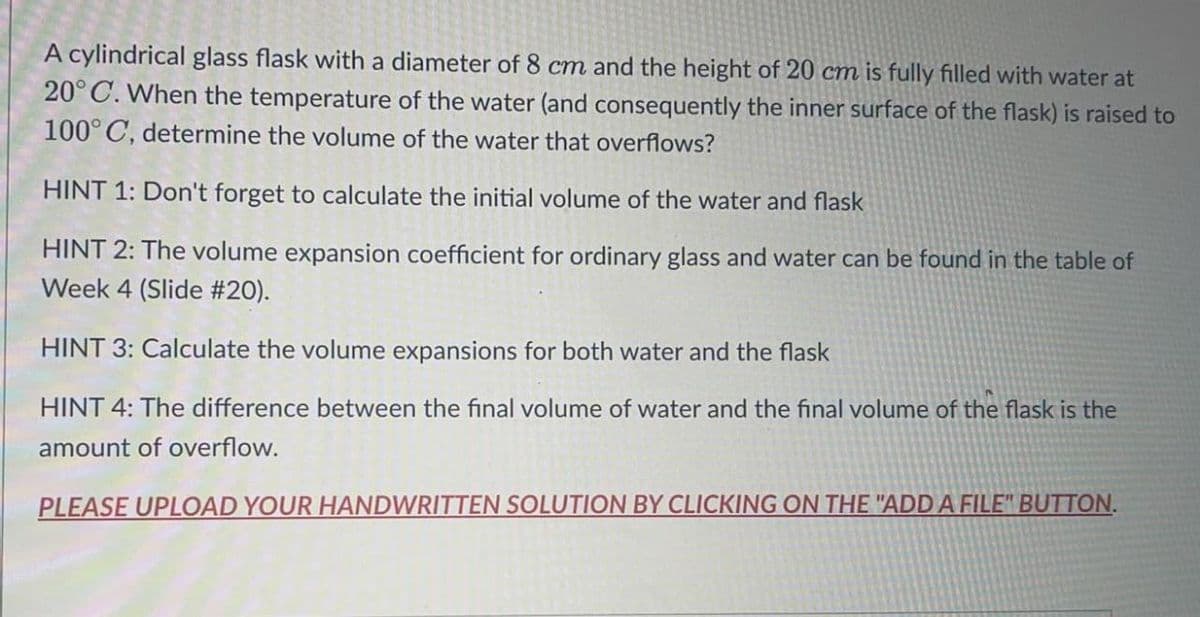A cylindrical glass flask with a diameter of 8 cm and the height of 20 cm is fully filled with water at 20°C. When the temperature of the water (and consequently the inner surface of the flask) is raised to 100°C, determine the volume of the water that overflows? HINT 1: Don't forget to calculate the initial volume of the water and flask HINT 2: The volume expansion coefficient for ordinary glass and water can be found in the table of Week 4 (Slide #20). HINT 3: Calculate the volume expansions for both water and the flask HINT 4: The difference between the final volume of water and the final volume of the flask is the amount of overflow. PLEASE UPLOAD YOUR HANDWRITTEN SOLUTION BY CLICKING ON THE "ADD A FILE" BUTTON.
A cylindrical glass flask with a diameter of 8 cm and the height of 20 cm is fully filled with water at 20°C. When the temperature of the water (and consequently the inner surface of the flask) is raised to 100°C, determine the volume of the water that overflows? HINT 1: Don't forget to calculate the initial volume of the water and flask HINT 2: The volume expansion coefficient for ordinary glass and water can be found in the table of Week 4 (Slide #20). HINT 3: Calculate the volume expansions for both water and the flask HINT 4: The difference between the final volume of water and the final volume of the flask is the amount of overflow. PLEASE UPLOAD YOUR HANDWRITTEN SOLUTION BY CLICKING ON THE "ADD A FILE" BUTTON.
Physics for Scientists and Engineers, Technology Update (No access codes included)
9th Edition
ISBN:9781305116399
Author:Raymond A. Serway, John W. Jewett
Publisher:Raymond A. Serway, John W. Jewett
Chapter19: Temperature
Section: Chapter Questions
Problem 19.11OQ: The average coefficient of linear expansion of copper is 17 106 (C)1. The Statue of Liberty is 93...
Related questions
Question

Transcribed Image Text:A cylindrical glass flask with a diameter of 8 cm and the height of 20 cm is fully filled with water at
20°C. When the temperature of the water (and consequently the inner surface of the flask) is raised to
100° C, determine the volume of the water that overflows?
HINT 1: Don't forget to calculate the initial volume of the water and flask
HINT 2: The volume expansion coefficient for ordinary glass and water can be found in the table of
Week 4 (Slide #20).
HINT 3: Calculate the volume expansions for both water and the flask
HINT 4: The difference between the final volume of water and the final volume of the flask is the
amount of overflow.
PLEASE UPLOAD YOUR HANDWRITTEN SOLUTION BY CLICKING ON THE "ADD A FILE" BUTTON.
Expert Solution
This question has been solved!
Explore an expertly crafted, step-by-step solution for a thorough understanding of key concepts.
Step by step
Solved in 2 steps

Knowledge Booster
Learn more about
Need a deep-dive on the concept behind this application? Look no further. Learn more about this topic, physics and related others by exploring similar questions and additional content below.Recommended textbooks for you

Physics for Scientists and Engineers, Technology …
Physics
ISBN:
9781305116399
Author:
Raymond A. Serway, John W. Jewett
Publisher:
Cengage Learning

Principles of Physics: A Calculus-Based Text
Physics
ISBN:
9781133104261
Author:
Raymond A. Serway, John W. Jewett
Publisher:
Cengage Learning

College Physics
Physics
ISBN:
9781305952300
Author:
Raymond A. Serway, Chris Vuille
Publisher:
Cengage Learning

Physics for Scientists and Engineers, Technology …
Physics
ISBN:
9781305116399
Author:
Raymond A. Serway, John W. Jewett
Publisher:
Cengage Learning

Principles of Physics: A Calculus-Based Text
Physics
ISBN:
9781133104261
Author:
Raymond A. Serway, John W. Jewett
Publisher:
Cengage Learning

College Physics
Physics
ISBN:
9781305952300
Author:
Raymond A. Serway, Chris Vuille
Publisher:
Cengage Learning

College Physics
Physics
ISBN:
9781285737027
Author:
Raymond A. Serway, Chris Vuille
Publisher:
Cengage Learning

Physics for Scientists and Engineers with Modern …
Physics
ISBN:
9781337553292
Author:
Raymond A. Serway, John W. Jewett
Publisher:
Cengage Learning

Physics for Scientists and Engineers
Physics
ISBN:
9781337553278
Author:
Raymond A. Serway, John W. Jewett
Publisher:
Cengage Learning